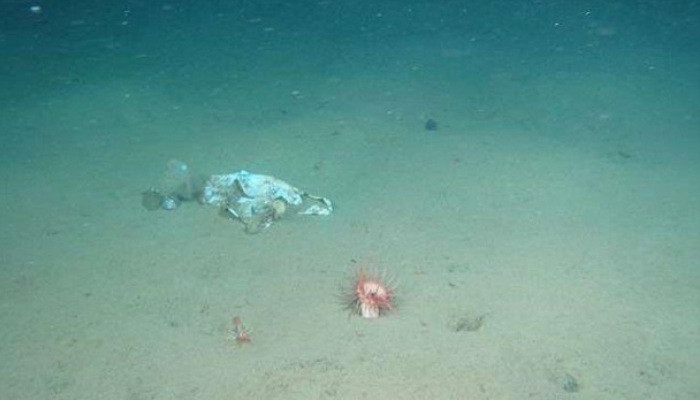Explorer Reaches Bottom of the Mariana Trench, Breaks Record for Deepest Dive Ever
 Explorer and businessman Victor Vescovo descended 35,853 feet (10,927 meters) into the Pacific Ocean, breaking the record for deepest dive ever. At the very bottom, he found colorful rocky structures, weird critters and the ever-pervasive mark of humankind — plastic. Until now, only two people have successfully made it to the bottom of Challenger Deep, the planet's deepest point at the southern end of the Mariana Trench. Back in 1960, oceanographer Don Walsh was the first to make it down to the trench successfully, reaching about 35,814 feet (10,916 m). He took the journey with Swiss oceanographer and engineer Jacques Piccard. Over 50 years later, Canadian explorer and filmmaker (writer and director of movies such as "Avatar" and the "“Titanic") James Cameron took the first solo dive and reached a depth of 35,787 feet (10,908 m). In the recent dive, Walsh accompanied a team up above on the ship, as Vescovo descended alone in a submersible called the DSV Limiting Factor. It took 3.5 to 4 hours to reach the record-breaking depth — a flat, beige basin covered with a thick layer of silt. Explorer and businessman Victor Vescovo descended 35,853 feet (10,927 meters) into the Pacific Ocean, breaking the record for deepest dive ever. At the very bottom, he found colorful rocky structures, weird critters and the ever-pervasive mark of humankind — plastic. Until now, only two people have successfully made it to the bottom of Challenger Deep, the planet's deepest point at the southern end of the Mariana Trench. Back in 1960, oceanographer Don Walsh was the first to make it down to the trench successfully, reaching about 35,814 feet (10,916 m). He took the journey with Swiss oceanographer and engineer Jacques Piccard. [In Photos: James Cameron's Epic Dive to Challenger Deep] Advertisement
Over 50 years later, Canadian explorer and filmmaker (writer and director of movies such as "Avatar" and the "“Titanic") James Cameron took the first solo dive and reached a depth of 35,787 feet (10,908 m). In the recent dive, Walsh accompanied a team up above on the ship, as Vescovo descended alone in a submersible called the DSV Limiting Factor. It took 3.5 to 4 hours to reach the record-breaking depth — a flat, beige basin covered with a thick layer of silt.
It was chilly; it was quiet; and "it was so very peaceful," he told Live Science. "I was surrounded by enormous pressure, but I was safely cocooned in my technological bubble." The pressure at that depth is about 16,000 pounds per square inch, over a thousand times more than the pressure at sea level. After Vescovo's record-breaking dive, other team members took four other subsequent dives to the trench. In the depths, during those five dives, they discovered red and yellow rocky outcrops that could be chemical deposits or bacterial mats, which are made by chemosynthetic microbes, meaning they can convert carbon-containing molecules into organic matter. They also observed a variety of critters. "There were some small, translucent animals," gently moving about, Vescovo said. They saw arrowtooth eels at 9,843 feet (3,000 m) and a wriggly little spoon worm (Echuria) at 22,966 feet (7,000 m). At 26,247 feet (8,000 m), they observed Mariana snailfish and supergiant amphipods (Alicella species) — creatures about 20 times larger than typical amphipods. The team also found what they think are four new species of amphipods, or shell-less crustaceans. They found one 8,530 feet (2,600 m) below the surface, one 14,600 feet (4,450 m) and two at the deepest point they reached. At the deepest point, they were accompanied by some transparent bottom-dwelling sea cucumbers (Holothurians) and an amphipod called the Hirondellia gigas. Because on previous missions these amphipods have been found to have microplastics in their guts, the team collected samples to test how much. Sitting there in the deepest point of the planet, Vescovo also came across a plastic bag and candy wrappers. |

Japan Unveils Human Washing Machine, Now You Can Get Washed Like Laundry (video)
161201.12.2025, 20:45
Chinese humanoid robot sets Guinness World Record with 106-km inter-city walk (video)
102924.11.2025, 16:30
Musk։ Optimus will be able to eliminate poverty and provide everyone with a universal high income (video)
100123.11.2025, 12:45
AGMI researchers expose the hidden role of female perpetrators in the Armenian Genocide (photo)
95213.11.2025, 21:15
LVM3-M5 mission successfully launches CMS-03 satellite (video)
122502.11.2025, 21:17
Google разработала квантовый алгоритм, работающий в 13 тыс. раз быстрее алгоритма суперкомпьютеров
156422.10.2025, 23:44
